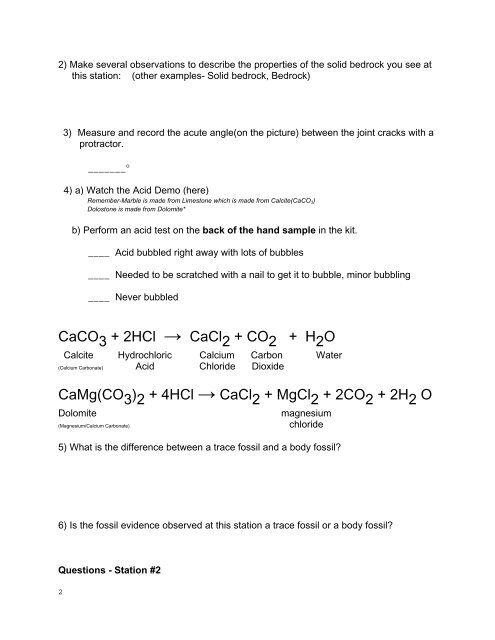Printable Copy of the Field Study Guide (PDF)
Printable Copy of the Field Study Guide (PDF) Printable Copy of the Field Study Guide (PDF)
Station #2: Swirls and Cracks Activities 1) Make both a rubbing and a sketch of the swirls from the bedrock sample. (sample provided in the kit) Label your results (Zoophycus- Schoharie grit worm). Rubbing: Sketch: 1
2) Make several observations to describe the properties of the solid bedrock you see at this station: (other examples- Solid bedrock, Bedrock) 3) Measure and record the acute angle(on the picture) between the joint cracks with a protractor. _______° 4) a) Watch the Acid Demo (here) Remember-Marble is made from Limestone which is made from Calcite(CaCO 3 ) Dolostone is made from Dolomite* b) Perform an acid test on the back of the hand sample in the kit. ____ Acid bubbled right away with lots of bubbles ____ Needed to be scratched with a nail to get it to bubble, minor bubbling ____ Never bubbled CaCO 3 + 2HCl → CaCl 2 + CO 2 + H 2 O Calcite Hydrochloric Calcium Carbon Water (Calcium Carbonate) Acid Chloride Dioxide CaMg(CO 3 ) 2 + 4HCl → CaCl 2 + MgCl 2 + 2CO 2 + 2H 2 O Dolomite (Magnesium/Calcium Carbonate) magnesium chloride 5) What is the difference between a trace fossil and a body fossil? 6) Is the fossil evidence observed at this station a trace fossil or a body fossil? Questions - Station #2 2
- Page 1 and 2: June's place Gravel Pit Site: Clark
- Page 3 and 4: 5) Describe the series of events th
- Page 5 and 6: Relative Age Ripple Marks Root Wedg
- Page 7 and 8: 5. Since only one reading for the g
- Page 9: Questions - Station #1 1) (a) How d
- Page 13 and 14: (b) Suggest how these cracks were f
- Page 15 and 16: Side of Boulder Fossil in Boulder
- Page 17 and 18: 5) Make several detailed observatio
- Page 19 and 20: 5) (a) Why do the tree roots appear
- Page 21 and 22: Profile Activities _________ % Usin
- Page 23 and 24: time it takes to form a pothole? Ex
- Page 25 and 26: Sketch a cross-section across the s
- Page 27 and 28: 2) Relative date the following from
2) Make several observations to describe <strong>the</strong> properties <strong>of</strong> <strong>the</strong> solid bedrock you see at<br />
this station: (o<strong>the</strong>r examples- Solid bedrock, Bedrock)<br />
3) Measure and record <strong>the</strong> acute angle(on <strong>the</strong> picture) between <strong>the</strong> joint cracks with a<br />
protractor.<br />
_______°<br />
4) a) Watch <strong>the</strong> Acid Demo (here)<br />
Remember-Marble is made from Limestone which is made from Calcite(CaCO 3 )<br />
Dolostone is made from Dolomite*<br />
b) Perform an acid test on <strong>the</strong> back <strong>of</strong> <strong>the</strong> hand sample in <strong>the</strong> kit.<br />
____ Acid bubbled right away with lots <strong>of</strong> bubbles<br />
____ Needed to be scratched with a nail to get it to bubble, minor bubbling<br />
____ Never bubbled<br />
CaCO 3 + 2HCl → CaCl 2 + CO 2 + H 2 O<br />
Calcite Hydrochloric Calcium Carbon Water<br />
(Calcium Carbonate) Acid Chloride Dioxide<br />
CaMg(CO 3 ) 2 + 4HCl → CaCl 2 + MgCl 2 + 2CO 2 + 2H 2 O<br />
Dolomite<br />
(Magnesium/Calcium Carbonate)<br />
magnesium<br />
chloride<br />
5) What is <strong>the</strong> difference between a trace fossil and a body fossil?<br />
6) Is <strong>the</strong> fossil evidence observed at this station a trace fossil or a body fossil?<br />
Questions - Station #2<br />
2



